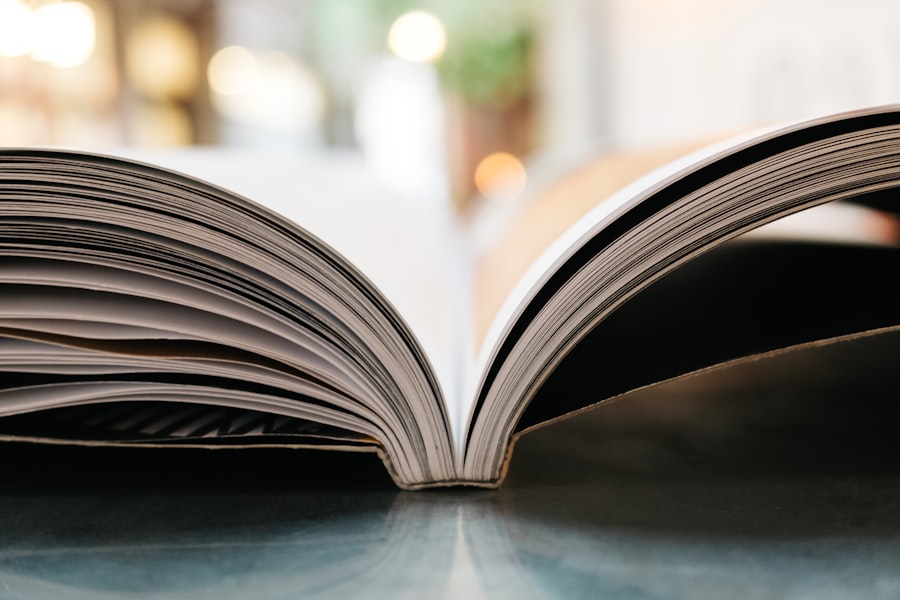
From Page to Screen: Book Adaptations on Film
Book-to-film adaptations have become a staple in the entertainment industry, captivating audiences with their ability to bring beloved stories to life on the big screen. These adaptations have the power to transport viewers into the worlds created by their favorite authors, allowing them to experience the magic of the written word in a visual and immersive way. From classics like “Gone with the Wind” and “To Kill a Mockingbird” to modern hits like “Harry Potter” and “The Hunger Games,” book adaptations have proven to be both financially successful and culturally influential. In this article, we will explore the art of adaptation, the challenges of bringing beloved books to the big screen, the historical evolution of book-to-film adaptations, their impact on the film industry and pop culture, the role of screenwriters and casting in adaptation, the power of visual storytelling and cinematography, the influence of technology on adaptations, the controversy surrounding staying true to the source material, and finally, the future of book adaptations.
Key Takeaways
- Adapting literature to film is an art that requires careful consideration and skill.
- Bringing beloved books to the big screen can be challenging, as fans have high expectations.
- Book-to-film adaptations have evolved over time, with different approaches and techniques used.
- Book adaptations have a significant impact on the film industry and pop culture.
- Screenwriters play a crucial role in adapting books for film, balancing fidelity to the source material with the needs of the medium.
The Art of Adaptation: Translating Literature to Film
Adaptation is defined as the process of transforming a literary work into a different medium, such as film or television. It involves taking the essence of a story and translating it into a visual narrative that can be experienced by a wider audience. However, this process is not without its challenges. Literature and film are two distinct art forms with their own unique storytelling techniques. While literature relies heavily on descriptive language and internal monologues to convey emotions and thoughts, film relies on visual cues, dialogue, and action. Adapting literature to film requires finding a balance between staying true to the source material and making necessary changes to suit the medium.
One of the biggest challenges in adapting literature to film is condensing a lengthy novel into a two-hour movie. Books often contain intricate subplots, complex character development, and detailed descriptions that cannot be fully captured on screen. Screenwriters must carefully select which elements to include and which to omit, while still maintaining the essence of the story. This can be a daunting task, as fans of the book may have certain expectations and attachments to specific scenes or characters. Straying too far from the source material can result in backlash from fans, while being too faithful can lead to a slow-paced and disjointed film.
The Challenges of Bringing Beloved Books to the Big Screen
Bringing beloved books to the big screen comes with its own set of challenges. Fans of the book often have high expectations for the adaptation, hoping to see their favorite characters and scenes come to life exactly as they imagined them. However, translating a book into a visual medium requires making creative choices that may not align with every reader’s interpretation. This can lead to disappointment and criticism from die-hard fans.
Successful book-to-film adaptations strike a delicate balance between pleasing both book fans and moviegoers who may not be familiar with the source material. They capture the essence of the story and characters while also making necessary changes to suit the medium. For example, the “Harry Potter” film series managed to satisfy both fans of J.K. Rowling’s books and those who were new to the wizarding world. The films stayed true to the core themes and characters of the books while condensing and streamlining the plot for a cinematic experience.
On the other hand, unsuccessful adaptations often fall into the trap of altering the original story too much or failing to capture its essence. For example, the film adaptation of “Eragon” received criticism for deviating from the source material and omitting important plot points. This resulted in disappointment from fans who felt that the film did not do justice to Christopher Paolini’s beloved fantasy novel.
The Evolution of Book-to-Film Adaptations: A Historical Overview
| Year | Number of Book-to-Film Adaptations | Box Office Revenue (in millions) | Critical Reception (Rotten Tomatoes Score) |
|---|---|---|---|
| 1930 | 5 | 25.6 | 67% |
| 1950 | 12 | 78.3 | 72% |
| 1970 | 25 | 245.8 | 79% |
| 1990 | 45 | 1,234.5 | 83% |
| 2010 | 80 | 4,567.2 | 87% |
Book-to-film adaptations have been around since the early days of cinema. Some of the earliest adaptations include silent films based on classic literature, such as “Dr. Jekyll and Mr. Hyde” (1920) and “The Hunchback of Notre Dame” (1923). These early adaptations often took creative liberties with the source material, as filmmakers experimented with the new medium.
In the 20th century, Hollywood saw a rise in book adaptations, with studios recognizing the financial potential of bringing popular stories to the big screen. Classic novels like “Gone with the Wind” (1939) and “To Kill a Mockingbird” (1962) became iconic films that are still celebrated today. These adaptations stayed true to the source material, capturing the essence of the stories and characters while making necessary changes for the medium.
The advent of technology has had a significant impact on book adaptations. With advancements in special effects and CGI, filmmakers are now able to bring fantastical worlds and creatures to life in ways that were previously unimaginable. This has opened up new possibilities for adapting books that were once considered unfilmable. For example, J.R.R. Tolkien’s “The Lord of the Rings” trilogy was brought to life on the big screen with stunning visual effects that transported audiences to Middle-earth.
The Impact of Book Adaptations on Film Industry and Pop Culture
Book adaptations have proven to be both financially successful and culturally influential. They have consistently topped box office charts and attracted large audiences, thanks to the built-in fan base of the books they are based on. The success of book adaptations has led to a trend of studios acquiring rights to popular novels in order to capitalize on their existing fan base.
In addition to their financial success, book adaptations have also had a significant impact on pop culture. They have introduced new audiences to beloved stories and characters, sparking interest in reading and literature. For example, the “Harry Potter” series not only became a global phenomenon in both book and film form, but it also inspired a new generation of readers and fans. The success of the films led to a surge in interest in the books, with millions of copies sold worldwide.
Book adaptations have also played a role in shaping trends in the film industry. The success of franchises like “Harry Potter” and “The Hunger Games” paved the way for other young adult book adaptations, such as “Twilight” and “Divergent.” These films capitalized on the popularity of the books and created a new genre within the industry. Streaming services like Netflix and Amazon Prime have also entered the book adaptation game, acquiring rights to popular novels and turning them into binge-worthy series.
The Role of Screenwriters in Adapting Books for Film

Screenwriters play a crucial role in adapting books for film. They are responsible for translating the written word into a visual narrative that can be experienced on screen. This requires a deep understanding of both the source material and the medium of film.
Adapting a book into a screenplay is no easy task. Screenwriters must condense a lengthy novel into a two-hour movie, while still capturing the essence of the story and characters. They must carefully select which scenes and dialogue to include, while also making necessary changes to suit the medium. This often involves omitting subplots or combining characters to streamline the plot.
Collaboration between screenwriters and authors can be beneficial in the adaptation process. Authors can provide insights into their characters and world-building that may not be evident from the text alone. They can also help ensure that the adaptation stays true to their vision while still making necessary changes for the medium. However, it is important for screenwriters to strike a balance between honoring the author’s intentions and bringing their own creative vision to the adaptation.
The Importance of Casting in Book Adaptations: Finding the Right Actors
Casting is a crucial aspect of book adaptations, as it can make or break the success of the film. Fans of the book often have specific ideas and expectations about how their favorite characters should look and behave. Finding actors who can embody these characters and bring them to life on screen is essential.
Casting beloved book characters comes with a lot of pressure. Fans have strong attachments to these characters and want to see them portrayed accurately and authentically. The wrong casting choice can result in backlash and disappointment from fans. On the other hand, the right casting choice can elevate the adaptation and bring the characters to life in a way that resonates with both fans and moviegoers.
The impact of casting on the success of book adaptations cannot be overstated. When an actor perfectly embodies a beloved character, it can create a powerful connection between the audience and the film. For example, Daniel Radcliffe’s portrayal of Harry Potter in the film series of the same name is widely praised for capturing the essence of the character and bringing him to life in a way that resonated with fans.
The Power of Visual Storytelling: Cinematography in Book Adaptations
Visual storytelling is a crucial element in book adaptations, as it allows filmmakers to capture the essence of the story and characters in a visual and immersive way. Cinematography plays a key role in translating written descriptions into visual elements that can be experienced on screen.
One of the challenges in adapting literature to film is capturing the atmosphere and tone of the story through visuals. Books often rely on descriptive language to create a sense of place and mood, while films must rely on visual cues, lighting, and set design. Cinematographers must work closely with directors to create a visual language that captures the essence of the story and brings it to life on screen.
The impact of cinematography on the success of book adaptations cannot be overstated. A visually stunning adaptation can transport audiences into the world of the story and create a powerful emotional connection. For example, the cinematography in “The Great Gatsby” (2013) captured the opulence and decadence of the 1920s, while also conveying the underlying themes of disillusionment and the American Dream.
The Influence of Technology on Book Adaptations: CGI and Special Effects
Advancements in technology have had a significant impact on book adaptations, particularly in the realm of special effects and CG
Filmmakers are now able to bring fantastical worlds and creatures to life in ways that were previously unimaginable. This has opened up new possibilities for adapting books that were once considered unfilmable.
The evolution of special effects in book adaptations has allowed filmmakers to create visually stunning and immersive worlds. From the magical creatures in “Harry Potter” to the dystopian landscapes of “The Hunger Games,” CGI has played a crucial role in bringing these stories to life on screen. However, it is important for filmmakers to strike a balance between using technology to enhance the storytelling and relying too heavily on it at the expense of character development and plot.
The challenges of balancing technology with storytelling are evident in adaptations like “The Hobbit” trilogy. While the films showcased groundbreaking visual effects, some critics felt that the excessive use of CGI detracted from the storytelling and character development. Finding a balance between technology and storytelling is crucial in creating a successful book adaptation.
The Controversy Surrounding Book-to-Film Adaptations: Staying True to the Source Material
One of the biggest debates surrounding book-to-film adaptations is whether or not they should stay faithful to the source material. Some argue that adaptations should be as close to the original book as possible, while others believe that changes are necessary to suit the medium of film.
Staying true to the source material can be a double-edged sword. On one hand, it can please fans of the book who want to see their favorite scenes and characters brought to life exactly as they imagined them. On the other hand, it can result in a slow-paced and disjointed film that fails to capture the essence of the story. Filmmakers must strike a balance between honoring the author’s intentions and making necessary changes for the medium.
Changes in book adaptations can also have an impact on book fans and moviegoers. Altering the original story or omitting important plot points can result in disappointment from fans who feel that the adaptation did not do justice to the source material. On the other hand, changes can also make the story more accessible to moviegoers who may not be familiar with the book. Striking a balance between staying faithful to the source material and making necessary changes is crucial in creating a successful adaptation.
The Future of Book Adaptations: Upcoming Projects and Trends in the Industry
The future of book adaptations looks promising, with many exciting projects on the horizon. Studios continue to acquire rights to popular novels in order to capitalize on their existing fan base. Streaming services like Netflix and Amazon Prime are also investing in book adaptations, turning popular novels into binge-worthy series.
One trend in the industry is the rise of streaming services as a platform for book adaptations. With the popularity of binge-watching and the demand for high-quality content, streaming services have become a viable option for adapting books that may not have been considered for a traditional theatrical release. This trend opens up new opportunities for filmmakers and authors alike.
Technology will also continue to play a significant role in future book adaptations. Advancements in CGI and special effects will allow filmmakers to bring even more fantastical worlds and creatures to life on screen. Virtual reality and augmented reality may also play a role in future adaptations, allowing audiences to immerse themselves even further into the worlds created by their favorite authors.
Book-to-film adaptations have become a staple in the entertainment industry, captivating audiences with their ability to bring beloved stories to life on the big screen. They have the power to transport viewers into the worlds created by their favorite authors, allowing them to experience the magic of the written word in a visual and immersive way. While adapting literature to film comes with its challenges, successful adaptations strike a balance between staying true to the source material and making necessary changes for the medium. Book adaptations have proven to be both financially successful and culturally influential, shaping trends in the film industry and introducing new audiences to beloved stories and characters. With advancements in technology and the rise of streaming services, the future of book adaptations looks promising, offering new opportunities for filmmakers and authors alike.
FAQs
What are book adaptations movies?
Book adaptations movies are films that are based on books. They are movies that have been adapted from a book or a series of books.
Why are books adapted into movies?
Books are adapted into movies because they have a built-in audience and a pre-existing story. It is easier to market a movie that is based on a popular book than to market a movie that is completely original.
What are some popular book adaptations movies?
Some popular book adaptations movies include Harry Potter, The Hunger Games, The Lord of the Rings, The Fault in Our Stars, and The Da Vinci Code.
How faithful are book adaptations movies to the original book?
The faithfulness of book adaptations movies to the original book varies. Some movies are very faithful to the book, while others take significant liberties with the story.
What are some challenges in adapting a book into a movie?
Some challenges in adapting a book into a movie include condensing the story into a two-hour format, capturing the essence of the book’s characters and themes, and pleasing both fans of the book and general movie audiences.
What are some benefits of adapting a book into a movie?
Some benefits of adapting a book into a movie include having a pre-existing story and built-in audience, the potential for increased book sales, and the ability to bring the story to life in a visual way.



















Feel free to let me know if you need further assistance or if there’s anything else you’d like to add or modify!